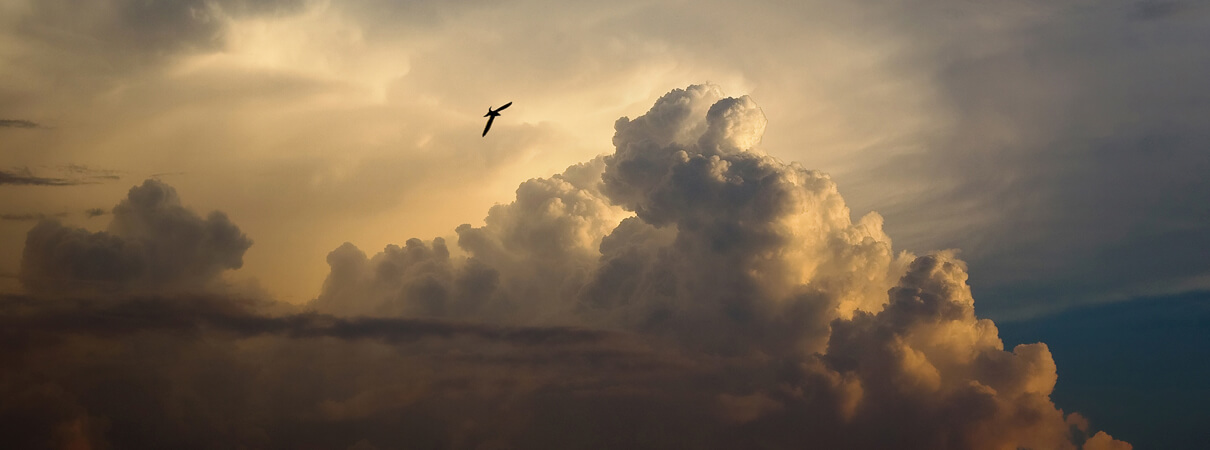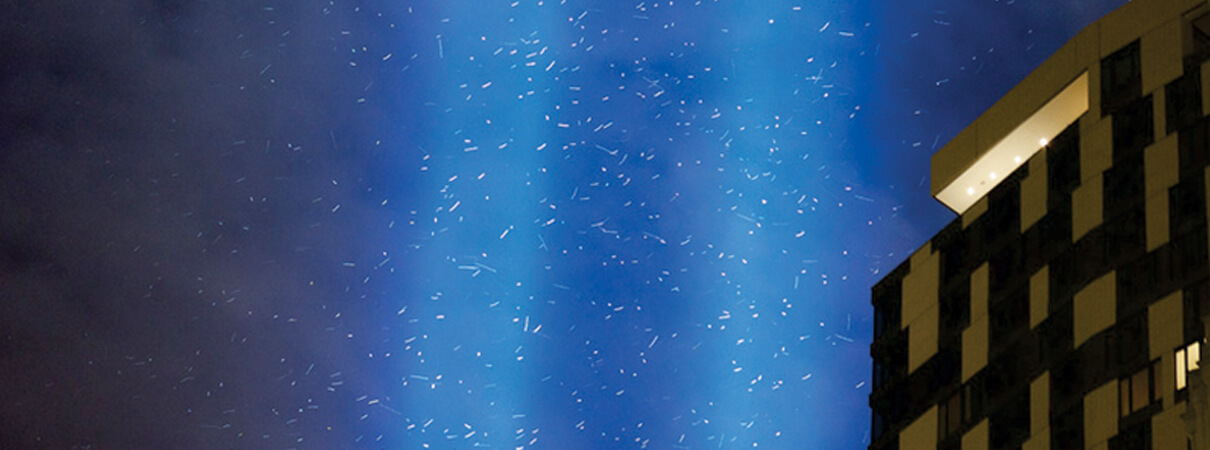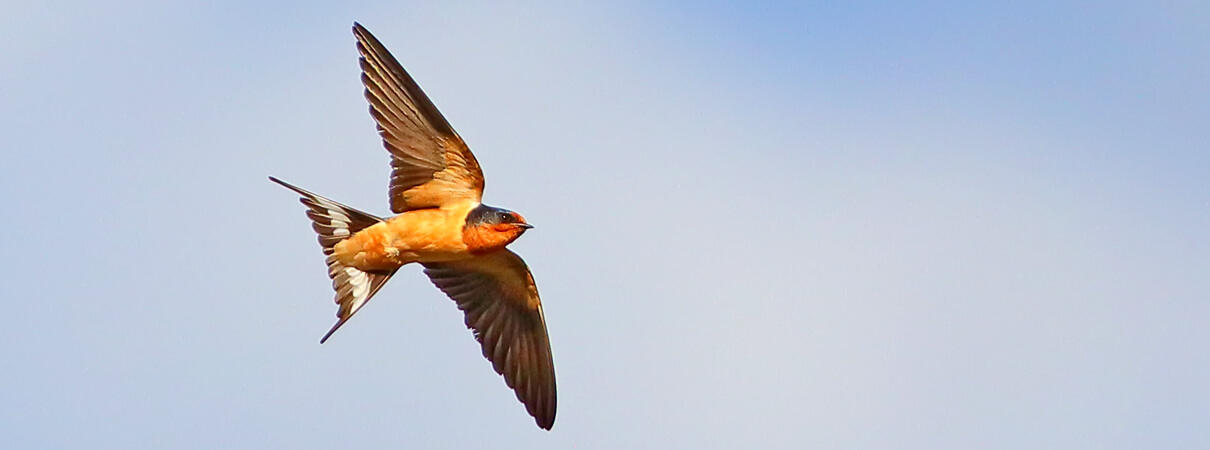For Birds, the Sky Isn't Just Empty Airspace. It's Habitat.
Look up. All that empty space over our heads isn't so empty. Many birds, bats, and insects spend a good part of their lives up in the air, foraging, mating, and migrating. Aerial insectivores such as swallows and swifts feed almost exclusively on the wing.
It doesn't look like habitat, but for these animals, the airspace is home. It's where they spend much of their lives. And as researchers are learning, what happens there carries life-or-death consequences.

New research is shaping what we know about airspace as vital habitat for birds. Photo by iiphevgeniy/Shutterstock
Aeroecology, as it's sometimes called, has come into its own as a field of research. This study of airspace as habitat is enabled by new technologies, by a rapidly expanding understanding of the complex ways animals interact with their environments, and by a growing interest in how human activities affect those environments. And it could have important implications for how conservation groups, including American Bird Conservancy (ABC), focus their work in coming years.
Threats in the Airspace
Knowing how birds use the airspace already helps drive ABC's work to minimize the dangers posed by wind turbines and communications towers. Aeroecology can help researchers and conservationists understand what happens to those birds in the air and how easy or safe it is to move from one location to another, an idea sometimes called “habitat connectivity.”
“We spend a lot of time studying birds on the ground, but they have to go from one place on the ground to another place on the ground. And the way they do that is, of course, by flying,” says Christine Sheppard, Director of ABC's Glass Collisions Program. “It exposes them to so many threats.”
Hers is one of several ABC programs that address hazards birds encounter in the airspace, including glass windows, tall buildings, wind turbines, power lines, communications towers, and artificial lighting. The collateral damage of these threats is staggering — and it's growing.
Birds can't see glass unless it it's modified to incorporate specific patterns or designs. Up to a billion birds a year die in the United States when they fly into windows of office buildings and homes. Many fall victim to communications towers and related guywires, which in the U.S. kill an estimated 7 million birds a year. That number should begin to decline as tower operators switch from steady-burning to blinking lights that are less disorienting for birds — a change in Federal Communications Commission guidelines that ABC was closely involved in bringing about.
Wind turbines kill many species of birds and bats that fly within the rotor-swept area. Others die on the power lines and related infrastructure that carry energy from wind energy facilities to power grids.

Wind turbines are one of many hazards birds encounter in the airspace. Photo by TiloG/Shutterstock
“It's tempting to think about habitat as being on the ground or in the water,” says Michael Hutchins, Director of ABC's Bird-Smart Wind Energy Campaign. “But for most birds, the sky is key. It's the highway they travel from wintering grounds to breeding grounds, or the place where they find food. It's essential to their survival. And we have to protect it just like we would any other type of habitat.”
Forests, Deserts — and Now Airspace
The idea that airspace should be thought of as habitat is relatively new. Many people, including a lot of ecologists and biologists, grew up thinking of habitat as land-based or aquatic environments. Forests, grasslands, and deserts counted. So did lakes, rivers, and marshes. Researchers might study the mechanics of a bird's flight or their nesting ecology, but overlook the conditions and threats that birds encounter on the wing.
In 2013, a research ecologist named Robert H. Diehl published a short but influential paper that helped define aeroecology as a field. Diehl works at the U.S. Geological Survey's Northern Rocky Mountain Science Center, and concentrates on studying migratory birds. Titled “The Airspace Is Habitat,” Diehl's paper explains why we should think more broadly about what constitutes habitat, and makes the case that airspace counts.
“The core concept of habitat has remained remarkably unchanged for decades,” Diehl writes. But airspace, he argues, fits into classic definitions of habitat as a place where an organism lives or goes to find the resources it needs for survival. This is important, because “recognition of airspace as habitat has implications for policy, regulation, and species conservation.”
Watch the Skies
Andrew Farnsworth is another scientist who has turned his attention to the sky. A Research Associate in Information Science at the Cornell Lab of Ornithology, Farnsworth specializes in migration biology and ecology. His work on migratory birds includes the use of bioacoustics — birds' flight calls and what they tell us, for instance — and the analysis of large amounts of weather radar data that can pick up where birds are moving, and when. Scientists can now use computers to filter out so-called biological events, like the presence of birds and bats, from weather events, and to analyze shifting patterns of movement over time.
Much of Farnsworth's time goes to studying how artificial light affects birds — one big branch of aeroecology research. Light pollution from brightly lit office towers or the glow of cities on the horizon, illuminated oil rigs, or other human-related sources can disrupt migratory birds or species active at night. Sometimes the results are fatal. It's a global problem: In Lima, Peru, for instance, fledgling Ringed Storm-Petrels disoriented by city lights end up grounded on the streets rather than soaring above the open Pacific, where they belong. An ABC-supported project in Lima connects residents who find the seabirds with veterinarians who rehabilitate them.
In one ground-breaking study, Farnsworth and other researchers analyzed the disruptive effects on birds caused by one famous urban light display: the Tribute in Light display in New York City that commemorates the victims of the 9/11 terrorist attacks. Farnsworth's team used radar and acoustic sensors along with direct observations to determine how those powerful beams of light changed birds' behavior. In a new journal article, researchers Benjamin Van Doren, Kyle Horton, and Farnsworth explain how they documented “significant behavior alterations”: birds aggregated in greater densities, flew more slowly, and vocalized much more frequently when the beams were illuminated. That was true even in good weather, when the birds' visibility wasn't hampered by clouds.

Artificial light can disrupt birds' migratory patterns. Pictured here: birds in the 9/11 Memorial lights in New York City. Photo by jnap/flickr
That doesn't mean cities have to go entirely dark to be more bird-friendly. Turning out lights at strategic times, like periods of peak migration, can reduce the disruption. Such tactics can be considered by local governments and even individual building owners looking to reduce the negative effects of light pollution.
How big a problem is artificial lighting? “You can see lights on the horizon from as far as 224 miles,” says Travis Longcore, an Assistant Professor of Architecture, Spatial Sciences, and Biological Sciences at the University of Southern California. That's irksome enough for humans. Birds, he says, are even more sensitive to certain parts of the light spectrum than humans are, relying on natural light cycles and sources to trigger certain behaviors, like when it's time to forage or roost.
‘The Final Ecological Frontier'
As human-related activity in the airspace has ramped up, so have technologies that allow Farnsworth, Longcore, and other researchers to get a better handle on the effects those activities have on birds. What these scientists are learning about the skies could have major implications for conservation and environmental policy.
Weather radar, critical to Farnsworth's work, has become a robust tool for analyzing the movements and concentrations of birds as they travel on their annual migrations and interact with human-related obstacles, including artificial light and various structures. At the Smithsonian Migratory Bird Center, for instance, Emily Cohen and colleagues have been using radar data to understand how birds migrate across the Gulf of Mexico and trace their specific paths — aerial knowledge that can help drive on-the-ground conservation work.
The work got a big boost in 2004 when the National Oceanic and Atmospheric Administration made its national weather radar data freely available. That gave researchers years' worth of data to analyze. And they had increasingly powerful computer programs with which to analyze it.
“The radar really opens your eyes to what's happening over a really large region,” says Jeffrey J. Buler, an Associate Professor of Wildlife Ecology at the University of Delaware, where he runs the Aeroecology Program. Using radar data, he has studied the stopover distributions of migratory birds throughout the Northeast.

For aerial insectivores such as this Barn Swallow, which feed almost exclusively on the wing, the airspace is vital habitat. Photo by Greg Homel/Natural Elements Productions
“We're starting to comprehend more what the effects of lighting might be on migrating birds,” Buler says. In a forthcoming paper, for instance, he and several co-authors share their analysis of multi-year radar data showing how brightly lit urban areas attract greater densities of migrating landbirds. Such information could boost municipal efforts to change cities' lighting policies, like the Lights Out and Dark Skies movements in Toronto, Chicago, and other major cities.
Earlier this year, three Canadian researchers — Christina M. Davy, Adam T. Ford, and Kevin C. Fraser — published a much-discussed paper in the journal Conservation Letters that talked about the implications of this growing body of work. Their paper reviews how much more we know now about airspace and the human-caused threats that make this vital habitat such an obstacle course for birds. Airspace, the authors suggest, could be “the final ecological frontier.”
Understanding threats to birds in the airspace is an essential complement to what scientists already know about birds on their breeding, feeding, and wintering grounds, says ABC's Sheppard. And it's crucial in ensuring a sustainable future for birds, she adds.
“We can't just look at where the bird is sitting now,” Sheppard says. “We have to look at where it's going next and how it's going to get there.”
ABC's Glass Collisions and Bird-Smart Wind Energy Campaigns are made possible through the generous support of the Leon Levy Foundation.
This article first appeared in the Fall 2017 issue of Bird Conservation magazine.
 | Jennifer Howard is Director of Public Relations at ABC. She was a writer and reporter with The Chronicle of Higher Education for 10 years and before that was a contributing editor and columnist with The Washington Post. Follow Jen on Twitter at @JenHoward. |


















































